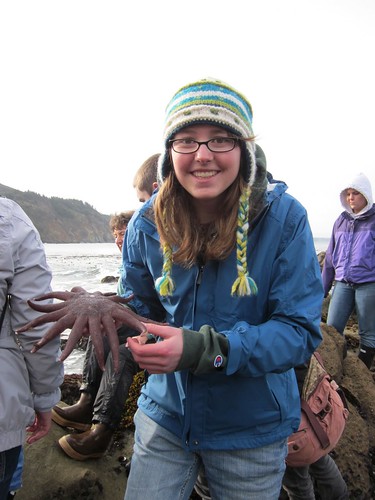Hello!
As a recent graduate of Oregon State University’s Marine Resource Management Program and a current NOAA Coastal Management Fellow, I have been asked to provide a description of the NOAA Coastal Management Fellowship program and the matching workshop that was held this past May.
The NOAA Coastal Management Fellowship is administered by the NOAA Coastal Services Center and is a 2 year fellowship where recent postgraduates are placed in state agencies to assist them in a variety of coastal management issues. Each year, state agencies that are responsible for administering their coastal zone programs submit proposals for a fellow. Six of these state agencies are chosen, and then a request is put out for recent postgraduates (or upcoming postgraduates) to apply. Each state’s Sea Grant is responsible for the initial interviews, and then may choose candidates to endorse to the NOAA Coastal Services Center. The Center then narrows the pool down to 12 postgraduate candidates to participate in a matching workshop with the 6 states that won the proposal bid. Whew! But it is not done yet! An intensive week long workshop ensues and 6 of the candidates are matched up with the 6 state projects. I’m here to describe my experience of this fun “American Idol” style workshop.
In May of 2012, NOAA Coastal Services Center flew me out to Charleston, S.C. where I and 10 other fellow candidates stayed in a historic inn in downtown Charleston. The first day was pretty low key for the candidates. Introductions were made and we were able to meet the 6 state mentors, our fellow candidates, some employees of the NOAA Coastal Services Center, and Tridec Technologies employees (the company that NOAA contracts with to pay the fellows). That first afternoon was packed full of state mentors presenting each of their proposed projects. The states were: Maryland, Delaware, Massachusetts, California, Washington, and the Commonwealth of the North Mariana Islands. This was an excellent opportunity to hear more about the projects and for candidates to better gauge their interest levels. It was also interesting to see that a couple of the state mentors were former NOAA Coastal Fellows!
Early the next morning, it was time for each of the candidates to present themselves. All presentations were fun to watch, everyone had a different style, but most presented on their graduate work, extra experiences, and bit of personal flare! That afternoon the candidates participated in a mentor-mentee workshop that was hosted by the center.
Wednesday was an all day marathon of interviews. Each interview was an hour, and you could sign up for as many or as few interviews as you wanted. I chose to interview with all six states, since I didn’t want to limit my options, plus it is a great networking opportunity! All of the week’s activities were hosted in the hotel, so it was very easy to stop by my room for a quick break in between interviews. Some of the interviews were held outside in a courtyard, while others were in the hotel rooms of the mentors. I had a great vibe throughout the process. Each mentor was relaxed and easy to talk to. They made a stressful situation as fun as it could be!
Thursday morning was follow-up interviews to give everyone a chance to address additional questions if needed. In the afternoon, candidates and mentors alike went to the beach for some sun and some fun! It was a great way to relax with fellow candidates and mentors. That evening all of us went out for dinner. Throughout the week candidates often got together for dinners and lunches. Charleston has excellent cuisine! Thursday evening we handed in our rankings. We could rank our top three state choices, and the mentors did the same. Then the Center matches everyone up according to the ranks.
Friday morning we were called down individually for the results. I got my #1 pick and am currently working for the Washington State Department of Ecology! I’m also happy to report that many of the candidates that were not matched at the workshop were able to find jobs that were excellent fits for them by the end of the summer! It was a bright and fun group of people, and I feel lucky to be a part of that group.
The overall experience of the workshop was very positive. Although it was stressful and nerve wracking at times, I felt that the NOAA Coastal Services Center put together a great environment that was inviting and relaxing. The attitudes of the mentors and my fellow candidates were always positive and greatly contributed to the success of the workshop. We joke that it is an “American Idol” type week, because we are all staying in the same hotel, we eat together, make friends, yet in the end we are competing against each other for a prestigious national fellowship. However, the group dynamic was fantastic and it was simply a joy to be around others who have the same passions for marine science, coastal issues, and sustainable management as I do.
For those of you interested in the upcoming NOAA Coastal Fellowship year, here are some links:
http://www.csc.noaa.gov/cms/fellows.html
http://seagrant.oregonstate.edu/fellowships/noaa-coastal-management
I’ve been working at the WA Department of Ecology for 3 months now. All is going well and I will be posting again in the upcoming months to describe a bit more of my project here in Washington!




